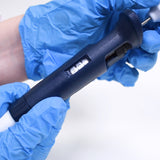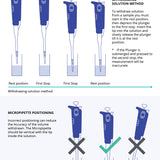Micropipettes in Microbiology

Micropipettes are an integral part of any biological or chemical laboratory as precise and accurate handling of liquids is necessary. Micropipettes allow scientists to transfer liquid in small volumes, usually in microliter (µL). The broad application of micropipettes across fields highlights their importance in the modern laboratory. Having a deep understanding of micropipettes, researchers are able to improve the accuracy and efficiency of their work.
The History of Micropipettes
In 1957, a researcher called Heinrich Schnitger at the University of Marburg in Germany invented the first pipette. Despite the achievement, the early version was a fragile capillary tube, which required expert handling and was not practical for use in the laboratory. This was followed by Dr Warren Gilson in 1960, who introduced the piston-based adjustable micropipette, also known as Gilson Pipetman. The advancement enabled accurate and controlled aspiration and dispensing of small liquid volumes.
There are several types of micropipettes but can be generalised into three types: the variable volume, fixed volume and multichannel micropipettes. A variable-volume micropipette allows the user to adjust the amount of liquid to be aspirated or dispensed, according to the specific needs of the task. It has a defined range and limit within which the volume can be adjusted. A fixed-volume micropipette is designed to aspirate and dispense a set amount of liquid. It is ideal for tasks that require dispensing the same volume repeatedly. Multichannel micropipettes feature multiple channels for aspirating and dispensing sample simultaneously. They are designed to reduce the workload associated with using a single-channel micropipette. These pipettes may have 8, 12, or 16 channels, allowing for efficient handling of multiple samples at once.
Micropipettes in Microbiology
Micropipettes in microbiology are used for the preparation of samples and reagents, as they add specific volume of solvent to a sample or reagent and dilute it. Micropipettes in microbiology are also often used for mixing samples by pressing and releasing the knob several times. Some of the experiments that require micropipettes include ELISA and PCR.
The mechanism of a micropipette is based on air displacement and piston movement. When the plunger is pressed, air inside the shaft is expelled, forcing liquid out of the micropipette tip. When the plunger is released, the piston moves upward, creating a vacuum that draws liquid into the tip.
Forward Pipetting
- Adjust the required volume using the adjustment knob to set the desired volume for liquid transfer.
- Attach a suitable micropipette tip.
- Press the plunger to the first stop, which will allow you to draw the liquid up.
- Dip the tip into the liquid and release the plunger to draw liquid up.
- Withdraw the tip, position it over the receiving vessel, and press the plunger to the second stop to dispense.
- Eject the used tip safely.
Reverse Pipetting
- Adjust the required volume using the adjustment knob to set the desired volume for liquid transfer.
- Attach a suitable micropipette tip.
- Press the plunger to the second stop instead of stopping at the first one. This prevents the liquid from being drawn up during aspiration.
- Dip the tip in the liquid and release the plunger to aspirate liquid.
- Withdraw the top and position it over the receiving vessel.
- Press the plunger only to the first stop to dispense the liquid.
- Discard the tip safely.
Applications of Micropipettes
- Chemical laboratories: Micropipettes in chemical laboratory are used to handle dangerous samples. They are often used in experiments that require precise measurement of a sample, reagent or solvent.
- Pharmaceutical laboratories: Micropipettes are used in pharmaceutical laboratories to asses the quality of pharmaceutical products. They are used to measure and dispense precise volumes during formulation process.
- Forensic laboratories: Micropipettes are used in forensic laboratories to analyse the blood, tissues, fibres and DNA material transferred from the crime scene.
- Microbiology laboratories: In microbiological laboratories, micropipettes are used for transferring reagents and samples in tests such as PCR and ELISA, and virus culture in cell lines.
- Molecular laboratories: Micropipettes are used in many experiments in molecular laboratories including DNA sequencing and western blotting.
- Food and beverage industry: In the food and beverage industry, micropipettes are used for handling liquids. They are implemented in quality control, diluting solutions and ensuring product safety.
Advantages of Micropipettes in Laboratories
Time Saving
Micropipettes are designed for precise and efficient liquid handling. They help researchers to dispense small liquid volumes quickly and accurately. Their time-saving design is especially useful for repetitive tasks or handling multiple samples. By ensuring accurate measurement and dispensing, micropipettes speed up laboratory workflows and increase productivity.
Ergonomics
Micropipettes' design makes them comfortable to use even during longer pipetting tasks, minimising user's fatigue. The lightweight structure, comfortable grip, and adjustable plunger forces make the micropipette useful for various purposes. This ergonomic design helps minimise the risk of repetitive strain injuries, ensuring a more comfortable and efficient pipetting process.
Accuracy and Precision
Micropipettes are known for their accuracy and precision in dispensing small liquid volumes. Calibrated to deliver exact amount within a defined rang, they ensure reproducible results and minimise experimental variability. Their precise measurement capabilities help researchers to perform accurate dilutions, sample transfers, and reaction setups, which are essential for obtaining reliable data.
Ease of Use
Micropipettes are designed for ease of use, featuring intuitive mechanisms for volume adjustment, aspiration, and dispensing. Pipette tips can be quickly attached and ejected, making transitions between samples easy. Their user-friendly design makes them accessible to both experienced researchers and beginners, promoting efficient and accurate pipetting.
Versatility
Micropipettes come in a range of volumes, enabling researchers to handle diverse sample sizes with precision. They can accurately dispense volumes from microlitres to millilitres, making them versatile tools across various scientific fields, including molecular biology, microbiology, and biochemistry. The availability of different pipette tip sizes and materials further enhances their adaptability.
Sample Preservation
Micropipettes allow for precise and controlled handling of delicate and valuable samples, including DNA, proteins, enzymes, and drugs. Their accurate measurement and gentle technique help minimise sample loss, contamination, and damage, ensuring the integrity and preservation of samples throughout the experimental process.
Disadvantages of Micropipettes
Manual Operation and Human Error
Micropipettes rely on manual operation, making them susceptible to human error. Variations in plunger pressure or misreading volume markings can result in inaccurate measurements. To ensure precision, proper technique and careful handling are essential to minimise potential errors.
Cell Damage During Mixing
When handling cells or sensitive samples, excessive force or vigorous pipetting can cause damage. Mechanical stress during mixing may lead to cell rupture, reduced viability, or altered cellular functions. To prevent this, it is essential to use gentle and appropriate mixing techniques to minimise cell damage.
Potential for Cross-Contamination
If liquid contacts the outer surface of the micropipette tip, cross-contamination may occur. This can result from touching a contaminated surface or accidentally aspirating liquid into the tip cone. Maintaining proper pipetting technique and using sterile practices can help minimise this risk.
Micropipette

Learn More
 Getting Started with a Micropipette
Getting Started with a Micropipette
Using your micropipette correctly ensures the most accurate and reproducible measuring and dispensing of solutions.
Read more... Micropipette: Positioning and Withdrawing
Micropipette: Positioning and Withdrawing
Follow our guide to correctly position and withdraw liquid with your micropipette.
Read more...